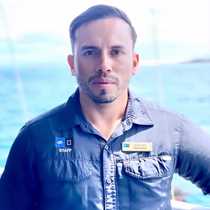Isabela Island
We continued our expedition around the fantastic landscapes of Isabela; this time we visited the central part of Isabela, disembarking on a place known as Urbina Bay. After a wet landing, we had a chance to go on a long hike along the uplifted area from 1954’s geological activity, which raised the ocean floor over three meters above sea level. Secondary in succession was the process creating life in this place, right on the same spot where ocean life use to exist once upon a time, but now this was the land for giant reptiles and yellow dragons of the Galapagos (giant tortoises and land iguanas). Many tortoises were seen along our hike as well as some land iguanas, we even found a couple of male iguanas fighting over territory right in the middle of our path. The area was already green as the rain in Galapagos had fallen for the last couple of days and that’s all it takes for the incense trees to bring back their leaves to green from their dormant stage.
Huge chunks of death coral were found into the island as they suffered the uplifting, barnacles on rocks and coralline algae on rocks were found far away from the coast. It was a unique experience to watch all this new part of the island being colonized. As we came back we saw many species in the tide pool along the coast; A moray eel, two octopi, plenty of small fish of all kinds, Sally lightfoot crabs and many colors dancing with the waves breaking on the young volcanic rocks on the shoreline.
During the afternoon, we arrived at Tagus Cove, a historical place found on the northern part of Isabela, where early sailors came to find protection from rough seas and to search for giant tortoises. Here, we snorkeled with Pacific green sea turtles, flightless cormorants, penguins and playful sea lions which stayed around for quite a while. Soon the rainy season did its magic and some of us went kayaking and hiking under the rain. While kayaking a sea lion pup jumped onto one of the kayaks and got a free ride, it was a true magical experience for our guests to see how interested wildlife was to interact with them and showed no fear whatsoever.




